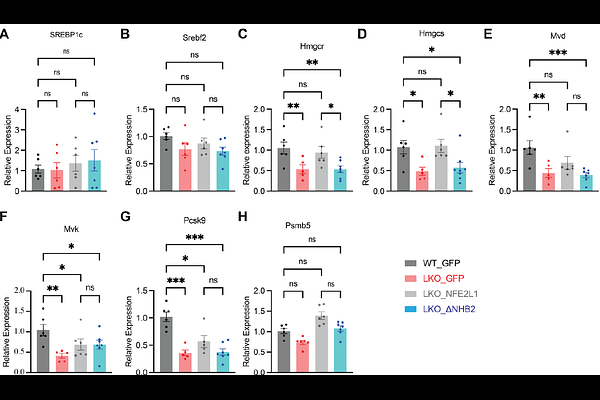Cholesterol-Responsive Interaction of NFE2L1-INSIG1 Controls VLDL Secretion and MASH Pathogenesis

Cholesterol-Responsive Interaction of NFE2L1-INSIG1 Controls VLDL Secretion and MASH Pathogenesis
Deng, S.; Freed, J.; Lee, G. Y.; Askin, G.; Cao, Z.; Cakici, O.; Yuan, B.; Hui, S. T.; Graupera, I.; Hotamisligil, G. S.
AbstractCholesterol overload drives metabolic dysfunction-associated steatohepatitis (MASH). While the liver maintains homeostasis by exporting cholesterol via very low-density lipoprotein (VLDL) secretion, this process is paradoxically suppressed under cholesterol excess by insulin-induced gene 1 (INSIG1), which inhibits sterol regulatory element-binding protein 1 (SREBP1) activity. How VLDL secretion persists during cholesterol overload to prevent lipotoxicity remains unresolved. We identify a cholesterol-responsive interaction between nuclear factor erythroid 2 related factor-1 (NFE2L1) and INSIG1 that sustains cholesterol balance. Hepatic NFE2L1 deficiency elevates INSIG1 levels, suppressing SREBP1 activation and impairing VLDL secretion, leading to cholesterol accumulation and liver injury. Mechanistically, NFE2L1 binds to INSIG1 via its N-terminal homology box 2 (NHB2) domain, with cholesterol enhancing this interaction to drive INSIG1 degradation and SREBP1 activation. In NFE2L1-deficient mice, wild-type NFE2L1 restores SREBP1 activity and VLDL secretion, while the NHB2-deleted mutant ({triangleup}NHB2) fails. Lipidomics reveal that NFE2L1 deficiency reduces serum triglyceride composition, restored exclusively by wild-type NFE2L1. In a murine MASH model, NFE2L1 overexpression activates SREBP1/2, enhances cholesterol secretion, and alleviates liver injury, inflammation and fibrosis, without elevating atherogenic lipoproteins due to compensatory LDL receptor upregulation. Our findings resolve the paradox of cholesterol-driven VLDL secretion and establish the NFE2L1-INSIG1 axis as a therapeutic target for metabolic diseases.